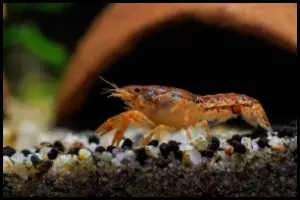
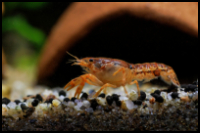
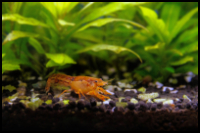

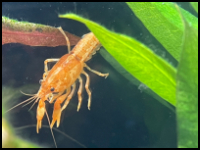
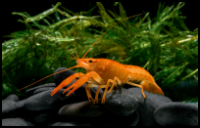
Quick Care Details (Table)
| Livestock Characteristics | Value |
|---|---|
| Care Level | Easy |
| Temperament | Peaceful |
| Diet | Omnivorous |
| Maximum Size | 2 inches |
| Minimum Tank Size | 10 gallons |
| Plant Safe | Yes |
| Temperature Range | 68-77°F (20-25°C) |
| PH Range | 6.5-8.0 |
| KH Range | 3-8 dKH |
| GH Range | 6-15 dGH |
Species Specific Categories
Helpful Video
Care Details
- Aquascape
Mexican Dwarf Crayfish (Cambarellus patzcuarensis) thrive in a well-planted aquarium with plenty of hiding spots. Incorporate rocks, driftwood, and live plants like Java moss to create a natural environment. This setup not only mimics their natural habitat but also provides them with areas to retreat, especially during molting. - Substrate
A soft, sandy substrate is ideal for Mexican Dwarf Crayfish. They enjoy digging and sifting through the substrate, and the soft sand prevents damage to their delicate appendages. Avoid sharp or rough substrates that could injure them. - Disease Prevention
Keeping water parameters stable is key to preventing diseases in Cambarellus patzcuarensis. Regular water changes, a well-maintained filter, and avoiding overcrowding in the tank will minimize stress and the likelihood of disease outbreaks. Quarantining new tank mates before adding them to the community also helps prevent the introduction of diseases. - Filtration
A gentle filtration system is best for Mexican Dwarf Crayfish. A sponge filter or a low-flow hang-on-back filter works well, ensuring the water remains clean without creating strong currents that could stress these small crayfish. - Lighting
Cambarellus patzcuarensis don’t have specific lighting needs, so standard aquarium lighting is sufficient. If you're keeping live plants in the tank, ensure the lighting supports plant growth, but the crayfish themselves don’t require intense light. - Water Flow
Mexican Dwarf Crayfish prefer calm waters, so it's important to keep water flow gentle. High flow can cause stress and make it difficult for them to move around comfortably. Positioning the filter output to minimize direct flow is a good idea. - Hardiness
Cambarellus patzcuarensis are relatively hardy and can adapt to a range of water parameters, making them suitable for beginner aquarists. However, they do best in stable conditions with a pH of 6.5-8.0 and a temperature between 68-77°F (20-25°C). - Acclimation
When introducing Mexican Dwarf Crayfish to a new tank, a slow acclimation process is recommended. Drip acclimation is a great method, gradually introducing them to the new water conditions to reduce stress and prevent shock. - Expected Lifespan
In optimal conditions, Cambarellus patzcuarensis can live for about 1.5 to 2 years. Providing a stable environment and proper care will help maximize their lifespan. - Special Requirements
One thing to note is that Mexican Dwarf Crayfish are escape artists, so it’s important to have a secure lid on your aquarium. They’re also sensitive to copper, so avoid medications or water treatments that contain copper, as it can be lethal to them. Additionally, maintaining a calcium-rich diet helps ensure proper shell development during molting.
Temperament and Behavior
- Behavior
Mexican Dwarf Crayfish (Cambarellus patzcuarensis) are generally peaceful and curious creatures. They spend much of their time exploring the aquarium, foraging for food, and interacting with their environment. While they are not shy, they do appreciate having plenty of hiding spots where they can retreat, especially during molting. - Breeding
Breeding Cambarellus patzcuarensis in a freshwater aquarium is relatively straightforward. Mating occurs naturally if conditions are right, with the female carrying fertilized eggs under her tail. She will protect the eggs until they hatch, usually after 3-4 weeks. Providing a safe, well-planted environment increases the chances of successful breeding and fry survival. - Aggression
Though they are generally peaceful, Mexican Dwarf Crayfish can exhibit some territorial behavior, especially during feeding or if space is limited. However, their small size and relatively mild temperament mean that any aggression is usually minor and doesn’t result in serious harm. - Tankmates Compatibility
Cambarellus patzcuarensis are compatible with a wide range of tank mates, especially small, peaceful freshwater fish and invertebrates. However, avoid keeping them with large or aggressive species that might see them as prey or competition. Fish that nip or have a tendency to bother bottom-dwellers should also be avoided. - Activity Level
These crayfish are fairly active, particularly during the day. They can often be seen scavenging the substrate, climbing on plants, or exploring the hardscape. While they are more active during daylight hours, they also exhibit some nocturnal behavior, especially if they feel threatened. - Schooling or Shoaling Behavior
Mexican Dwarf Crayfish are solitary by nature and do not school or shoal. While they can be kept in groups, it’s important to provide enough space and hiding places to prevent territorial disputes. A group of Cambarellus patzcuarensis in a well-planned tank can coexist peacefully, but they won’t display schooling behavior like many fish species do. - Plant Compatibility
Cambarellus patzcuarensis are generally plant-safe and will not typically uproot or damage live plants. In fact, they often enjoy resting on or hiding within dense plant foliage. They may occasionally nibble on delicate plant leaves, but they are unlikely to cause significant damage to most aquarium plants.
Diet and Nutrition
- Dry Foods
Mexican Dwarf Crayfish (Cambarellus patzcuarensis) can be fed high-quality dry foods such as sinking pellets or tablets specifically formulated for crustaceans. These should be high in protein and calcium to support their overall health and shell development. - Frozen Foods
They enjoy a variety of frozen foods, including bloodworms, brine shrimp, and daphnia. These foods provide a good source of protein and are a great supplement to their diet, helping to ensure they receive a balanced nutritional intake. - Live Foods
Live foods like small worms or insect larvae are excellent for Cambarellus patzcuarensis. They actively hunt and forage for live prey, which can be enriching and beneficial for their health. Make sure to provide appropriately-sized live foods to avoid overfeeding. - Vegetables
Mexican Dwarf Crayfish will also munch on blanched vegetables like zucchini, cucumber, or spinach. These should be softened by boiling or steaming to make them easier for the crayfish to eat. Vegetables provide essential nutrients and add variety to their diet. - Algae
While Cambarellus patzcuarensis will graze on algae in the tank, they should not rely solely on algae for their nutrition. Supplement their diet with more protein-rich and nutrient-dense foods to ensure they remain healthy and active. - Feeding Schedule
Feed your Mexican Dwarf Crayfish once or twice a day, providing only as much food as they can consume within a few minutes. Overfeeding can lead to water quality issues and obesity, so monitor their intake and adjust as needed. - Supplemental Foods
Occasionally, you can supplement their diet with calcium-rich foods or supplements to aid in shell development and maintenance. Crushed coral or calcium tablets added to the tank can also provide essential minerals.
Tank Parameters
- Tank Size
A minimum tank size of 10 gallons is recommended for Mexican Dwarf Crayfish (Cambarellus patzcuarensis). This provides ample space for them to explore and establish territory while also maintaining stable water conditions. - Tank Length and Measurements
A tank with a length of at least 20 inches is ideal. The length allows for a more spread-out environment, which is beneficial for their activity and reduces potential territorial disputes. A wider tank also provides more surface area for hiding spots and foraging. - Water Temperature
Maintain the water temperature between 68-77°F (20-25°C). Mexican Dwarf Crayfish are adaptable but thrive in this range, which supports their health and activity levels. Avoid rapid temperature fluctuations to prevent stress. - pH (Acidity/Alkalinity)
The pH should be kept between 6.5 and 8.0. Cambarellus patzcuarensis can tolerate a range within this spectrum, but stable pH levels are crucial for their well-being. - KH (Carbonate Hardness)
Aim for a KH of 3-8 dKH. Carbonate hardness helps to buffer the water and maintain stable pH levels, which is beneficial for the overall health of the Mexican Dwarf Crayfish. - GH (General Hardness)
A general hardness level of 6-15 dGH is suitable. This range provides essential minerals needed for shell development and overall health. - Hardiness
Cambarellus patzcuarensis are relatively hardy and can adapt to a range of water parameters. However, maintaining stable conditions within the recommended ranges will promote better health and longevity. - Nitrate (NO3) Levels
Keep nitrate levels below 20 ppm. High nitrate levels can stress Mexican Dwarf Crayfish and contribute to health issues. Regular water changes and a good filtration system help keep nitrate levels in check.
History, Popularity, History and Species Variety Details
The History, Popularity, and Natural Habitat
- History
The Mexican Dwarf Crayfish (Cambarellus patzcuarensis) is native to the freshwater lakes and streams of Mexico, specifically around Lake Patzcuaro. This species was first described scientifically in the 1980s, but its introduction to the aquarium hobby occurred later as its unique appearance and manageable size made it an appealing choice for enthusiasts. Initially, these crayfish were collected from their natural habitat for scientific study and aquarium trade, but they quickly gained popularity due to their small size and relatively easy care. - Popularity
The Mexican Dwarf Crayfish has become a favorite among aquarium hobbyists due to its small size, vibrant coloration, and interesting behavior. Its manageable size makes it suitable for smaller aquariums, and its peaceful nature, compared to larger crayfish species, adds to its appeal. In addition, their ease of care and ability to adapt to a range of water conditions have contributed to their popularity. As more aquarium enthusiasts have become interested in invertebrates, Cambarellus patzcuarensis has seen a rise in demand, becoming a common and well-loved species in the hobby. - Natural Habitat
In their natural environment, Mexican Dwarf Crayfish are found in the clear, slow-moving waters of Lake Patzcuaro and its surrounding streams in Mexico. This region features a mix of sandy and rocky substrates with abundant vegetation. The crayfish typically seek shelter among rocks and aquatic plants, which provide both food and protection. The water in their native habitat is generally soft to moderately hard, with stable temperatures and a neutral to slightly alkaline pH. Mimicking these conditions in captivity helps ensure their health and well-being.
Similar and Variations of the Species
- Similar Crayfish Species
- Cambarellus shufeldti: Another dwarf crayfish species with a similar size and habitat range, but differing in coloration and some behavioral traits.
- Cambarellus patzcuarensis (Orange Morph): A popular variant of the Mexican Dwarf Crayfish, known for its bright orange coloration.
- Cambarellus montezumae: A species with similar care requirements and behavior, but typically larger and with different color patterns.
- Variations
- Cambarellus patzcuarensis (Wild Type): The original coloration is more subdued with a mix of browns and greens.
- Cambarellus patzcuarensis (Blue Morph): A less common variation with a bluish tint, adding a unique touch to the aquarium setup.
- Cambarellus patzcuarensis (Albino Morph): Featuring an albino coloration, this variant is less common and often sought after by enthusiasts looking for unique appearances.
Frequently Asked Questions
How can I tell if my Mexican Dwarf Crayfish is male or female?
Males are typically smaller and more colorful, with larger claws compared to females. Females are usually larger and have a broader abdomen, especially when they are carrying eggs.
Can Mexican Dwarf Crayfish live with shrimp?
Yes, they can live with shrimp, but it's essential to ensure there are plenty of hiding spots. They might occasionally show interest in small shrimp, so monitor their interactions closely.
What should I do if my Mexican Dwarf Crayfish escapes the tank?
Act quickly! Ensure the tank has a secure lid. If you find your crayfish outside the tank, gently place it back in the water and check the tank environment for any issues that might have caused the escape.
Do Mexican Dwarf Crayfish need a special diet?
They do well with a balanced diet of high-quality sinking pellets, frozen foods like bloodworms and brine shrimp, and occasional blanched vegetables. A varied diet ensures they get all the nutrients they need.
How can I help my Mexican Dwarf Crayfish molt successfully?
Provide a calcium-rich environment with crushed coral or calcium supplements. Ensure they have plenty of hiding spots and a stable water environment to reduce stress during the molting process.

